Notice: Undefined variable: page in /home/vrxdg1855sn3/public_html/wp-content/themes/72tree/content.php on line 15
Notice: Trying to get property 'ID' of non-object in /home/vrxdg1855sn3/public_html/wp-content/themes/72tree/content.php on line 15
The Stunning Southern Magnolia Tree and its Flower
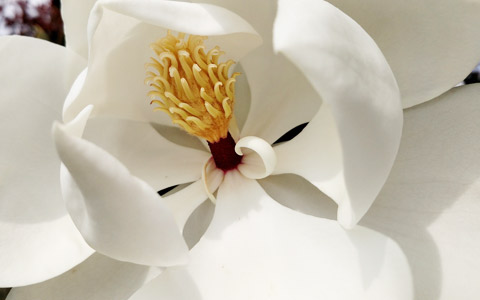
The Southern magnolia (Magnolia grandiflora) is an essential tree for yards and landscapes in hardiness zones 6 through 10, for its size, year-round beauty, and its enormous creamy white flowers.
72tree.com gathered essential information on the Southern magnolia tree, its characteristics, incredible flowers and their blooming season.
Magnolia Tree Information
Magnolia grandiflora, with its full luxurious look, is a favorite specimen around the world. The following are some of its features:
Family – Magnoliaceae
Height – 50 to 80 feet at maturity with some reaching 90 feet.
Width – The base of a fully mature magnolia can reach 40 feet in diameter.
Foliage – Mature leaves are dark glossy green and densely grow up to 8 inches in length by 5 inches wide.
DBH – The diameter at breast height of a fully mature magnolia tree can reach 24 to 36 inches.
Crown Width – This species grows in a pyramidal shape, its mid and lower sections can reach a diameter of 30 to 40 feet and tapers upward to a pointed or rounded crown.
Leaf Drop – While Magnolia grandiflora is an evergreen species, it will drop light foliage throughout the year.
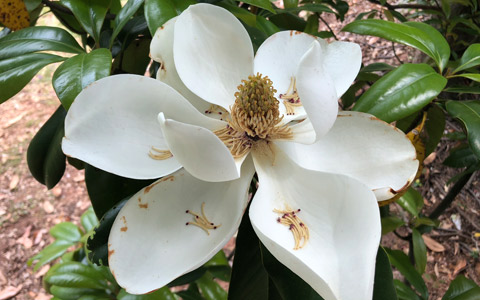
Blooms – The flowers of Magnolia grandiflora are creamy white and can reach up to 12 inches in diameter.
Pests – While magnolia trees are generally free of significant pest problems, some varieties of scale, aphids, mealybugs, spider mites, and leafminers present potential infestations.
Disease – There are several fungi which can cause leaf spots, and in some cases, may lead to heart rot. However, for the most part, fungi are unable to cause any significant damage to adult magnolias. In the event of severe leaf drop or branch dieback, an arborist should be called to evaluate the situation and recommend a course of action.
This magnificent species, native to the southeastern United States, has been planted in cities all over the world. It’s no wonder that Magnolia grandiflora became an instant hit when it was taken to Europe in the 1700s.
Due to its adaptability to many climates and soil types, and its unique beauty, this species has become one of the most widely planted ornamental evergreen trees in the world.
To learn more about the USDA Hardiness Zone Map, read Trees, Shrubs, and the USDA Hardiness Zone Map at 72tree.com/trees-shrubs-usda-hardiness-zone-map/
Magnolia Tree Flower
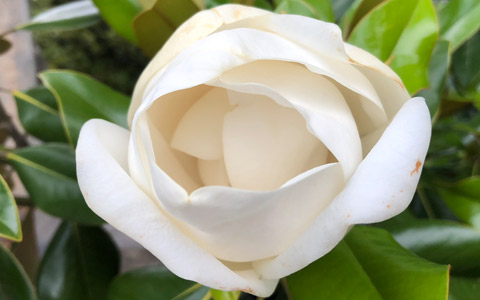
The majestic Southern magnolia tree has an incredibly dominating presence from mid-summer through the end of winter. However, in early to mid spring, this specimen displays its true glory and reason for its worldwide admiration.
When the Southern magnolia blooms, it blooms at the tips of twigs all over with dozens of white lemon citronella-scented flowers open at a time. Healthy mature magnolias bloom consecutively until mid-summer, and these enormous flowers range in size, reaching up to 12 inches in diameter and lasting up to 7 days from bloom to wilt.
The Magnoliaceae family is among the eldest of tree families in existence. Due to this, we get to witness two pre-evolutionary aspects of flowers:
Tepals, not Petals – In magnolia flowers, the petals are fused with the sepals (sepals are typically green and function as protection for the flower while in bud); therefore, the correct terminology for these parts is tepals. The tepals of the magnolia flower are usually arranged in two whorls of 3 to 6 tepals each.
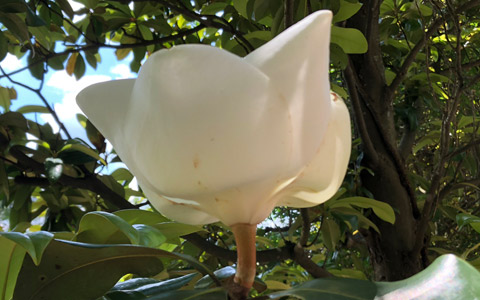
No Nectar Here – That’s correct, magnolia flowers do not produce nectar. These flowers attract pollinating beetles with their fragrant and sugary secretions.
The beautiful magnolia flower is the state flower of Mississippi and Louisiana, while the tree itself is the state tree of Mississippi. It should come as no surprise that the largest Southern magnolia is located in Smith County, Mississippi, measuring more than 122 feet tall with a DBH greater than 6 feet.
The Flowering Magnolia Grandiflora
If you live in the South and your landscape doesn’t include a Southern Magnolia, you’re missing out on one of the oldest and most beautiful blooming evergreen trees in existence.
In this article, you discovered a wealth of information about the Southern magnolia tree and its beautiful flowers.
If your property lies within hardiness zones 6 through 10, and you have yet to plant a magnolia tree, you should consider doing so for the beauty of the tree and the elegance of its sensational flowers.
Sources:
https://plants.ces.ncsu.edu/plants/all/magnolia-grandiflora/
https://hgic.clemson.edu/factsheet/magnolia/
https://www.arborday.org/trees/treeguide/TreeDetail.cfm?ItemID=863
https://edis.ifas.ufl.edu/st371
Notice: Undefined variable: page in /home/vrxdg1855sn3/public_html/wp-content/themes/72tree/content.php on line 15
Notice: Trying to get property 'ID' of non-object in /home/vrxdg1855sn3/public_html/wp-content/themes/72tree/content.php on line 15
Tree Planting Guide
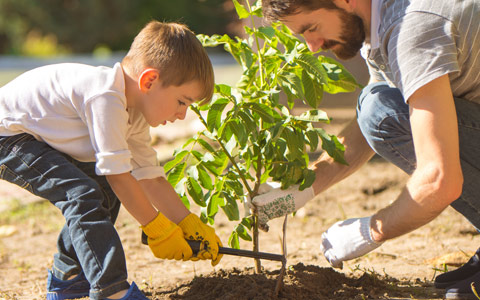
If you could make a significant contribution to the slowing of climate change and global warming, would you do it? With every tree you plant, you increase breathable air, reduce atmospheric CO2, and help the local ecosystem.
Planting a tree is the beginning of a journey with nature. The better the conditions are when planting a tree, the healthier it will be and faster it will grow.
72tree.com gathered the following hardiness zone, location, soil, watering, pruning, and care information to serve as a guide when planting a tree.
Tree Planting – Hardiness Zone
Tree species across the world have adapted to thrive in their respective environment. In the United States, the USDA has determined 11 hardiness zones by their average annual extreme low temperatures.
Before choosing a species to plant, you must first determine which hardiness zone the planting location is in. The following is the USDA’s Hardiness Zone Map.
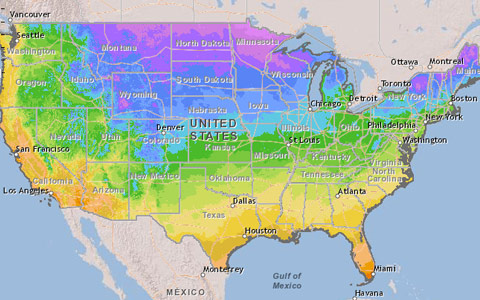
For an interactive version of the map, visit planthardiness.ars.usda.gov/phzmweb/interactivemap.aspx
As an example, the state of Georgia spans through hardiness zones 6b through 8b, making it suitable for maples, oaks, and poplars among others. For these and other shade trees suitable to plant in Alpharetta or Roswell Ga, visit 72tree.com/5-popular-alpharetta-ga-shade-trees/
Once you have determined the hardiness zone of the planting location, it’s time to consider the planting location and select a tree species.
Tree Planting – Location
While trees are impacted largely by climate, conditions within their immediate environment are equally as important. Take the following factors into consideration when choosing which species and where to plant:
Shade Tolerance – Each tree species may react differently to the amount of sunlight it is subjected to daily. Here are the shade tolerance categories:
• Shade Tolerant
• Intermediate Shade Tolerant
• Shade Intolerant
It is important to note that shade intolerant trees like poplars, eucalyptus, aspen, and pecan trees may self-prune (drop entire branches) if subject to partial or full shade environments.
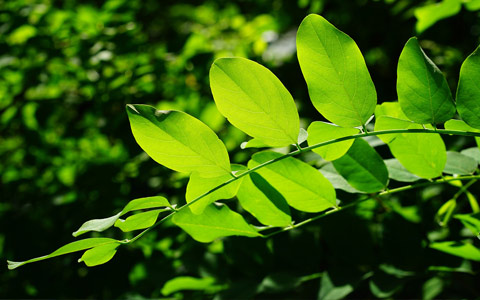
Wind Resistance – High winds and severe weather will test a tree’s foothold and its elasticity. Planting trees around the following wind-blocking features may help them survive the strongest of winds:
• Fences
• Shrubs
• Raised Garden Beds
• Hills
• Sheds
• Buildings
A tree’s resistance to severe weather is also determined by its overall health and seasonal pruning practices. Crown thinning is the perfect example of a pruning technique that allows wind to blow more freely through the crown, significantly reducing the potential for severe damage.
Understory Trees – These trees grow from 20 to 25ft tall and are shade tolerant. These trees are well suited for “plaza” settings or environments in which they are surrounded by buildings and a mostly shaded setting. In a forest, these are the trees that grow between the forest floor and the bottom of the overstory canopy.
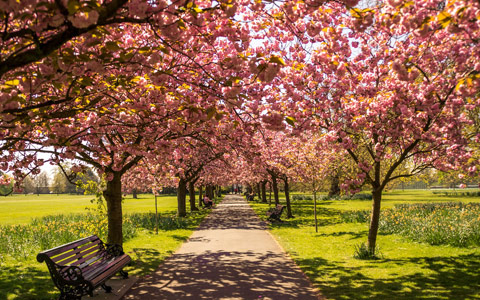
Overstory Trees – These trees grow from 40ft and beyond. Overstory trees are shade intolerant and require wide open space to reach their maximum height potential. In a forest, these are the trees that make up the uppermost part of the canopy.
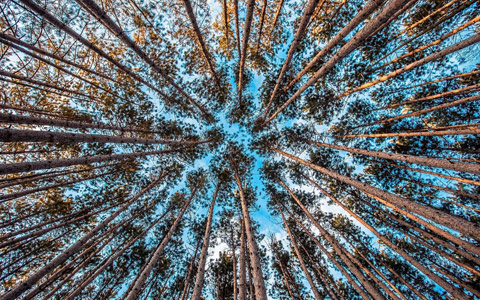
Root Growth – In nearly all tree species, some roots grow deep into the ground to stabilize the tree, and the vast majority of roots spread out around the tree within the top 2 to 3ft of soil in search of water and nutrients.
It is essential that your planting location be far enough away from sidewalks, pathways, driveways, and building foundations to avoid buckling and structural damage.
For more information on how tree roots affect surrounding structures, read 72tree.com/tree-roots-buckling-concrete-driveway/
Tree Planting – Soil
Since soil contains the organic matter and water a tree needs, it is obvious that the growth and health of your new tree depend heavily on the soil it is planted in. The following guidelines will help you prepare the soil for planting:
Soil Type – There are four basic types of soil:
• Sand – Sandy soil has difficulty retaining water and roots are often unable to establish themselves firmly.
• Silt – Silt is a granular quartz or feldspar material sized between sand and clay.
• Clay – Clay soil is the denser of the soil types, has poor drainage, and compacts very easily.
• Loam – Loam is a combination of the other three soil types and is widely considered to be the best soil for planting.
The majority of tree species flourish in well-drained silt or loam soil, while few are adapted to sand or clay soils.
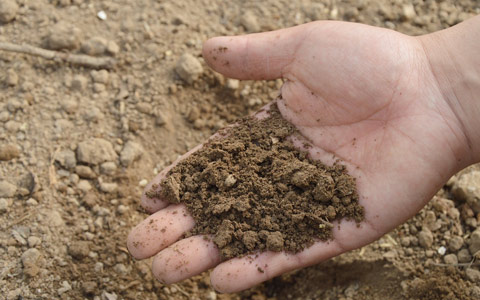
Soil pH Level – Neutral soils have a pH level of 6.5 to 7.5, acidic soils have a pH level below 6.5, and basic soils have a pH level higher than 7.5.
Depending on the species of your tree, it may grow better in acidic soil like pine trees, while most hardwoods do better in slightly acidic to neutral soil.
The pH level of the soil can be lowered by mixing in sulfur, and most fertilizers, while lime or organic mulch, can be added to raise the pH level.
When planting a tree, the soil within a 4 to 5ft radius around the trunk should have its pH adjusted to meet the needs of the tree species, and the soil mixed to a loam consistency to offer the best root development environment.
Tree Planting – Watering
For the first few years of growth, newly planted trees (in well-drained soil) require a deep watering every two weeks or so. Deep watering is when you allow a slow but steady stream of water to penetrate 10in or more into the soil.
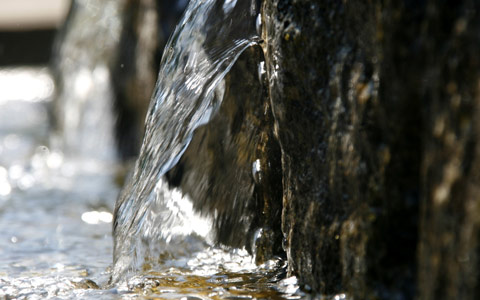
The benefit of deep watering is that roots will grow deeper into the soil, discouraging surface roots. Surface roots are easily damaged, allowing for either infection or infestation which weaken the tree’s health and could lead to its early death.
During rainy seasons, deep waterings should be spread further apart, every 3 to 4 weeks, and during dry seasons or times of drought, weekly deep waterings may be necessary.
Tree Care After Planting
After a full year of growth, it’s time to start applying routine tree care practices. In late fall, you can prune your tree to encourage spring growth, maintain its shape, or remove diseased or damaged limbs. Learn the various tree pruning techniques and their purpose so you avoid making an irreparable mistake.
Fertilizing should only occur between the beginning of spring and the beginning of summer. Fertilizing in mid or late summer will encourage new growth which will not have sufficient time to harden and will likely die in the winter months.
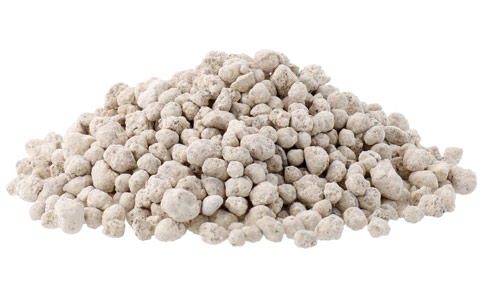
Set up an annual inspection with an ISA certified arborist. An arborist can give you valuable insight as to the influence your landscape has on your tree and vice-versa. He or she can also help in the early detection of disease, infestations, and other potential threats to your tree.
Tree Planting for a Better World
You can help slow the effects of climate change and global warming by planting a tree. With a world population of nearly 8 billion people, research shows that the 3 trillion trees currently occupying the planet with us just won’t be enough for human life to flourish in the coming centuries.
In this article, you discovered the USDA’s Hardiness Zone Map, tree planting guidelines for location selection, soil composition, watering frequencies, pruning, and care.
By neglecting the world’s diminishing tree population, we as a people are potentially condemning future generations to an inhospitable planet in which little – if any – life will be able to survive. When you plant and care for a tree, you are truly helping to save the planet and the future of mankind.
Sources:
http://www.americaslongleaf.org/media/2516/soil-ph-tree-suitability-in-the-south-_sref_.pdf
https://extension.psu.edu/forest-landowners-guide-to-tree-planting-success
https://csfs.colostate.edu/colorado-trees/selecting-planting-and-caring-for-trees/planting-tips/
https://forestry.usu.edu/trees-cities-towns/urban-forestry/landscape-trees-climate
https://www.extension.iastate.edu/forestry/publications/pdf_files/ctspsoilstrees.pdf
Notice: Undefined variable: page in /home/vrxdg1855sn3/public_html/wp-content/themes/72tree/content.php on line 15
Notice: Trying to get property 'ID' of non-object in /home/vrxdg1855sn3/public_html/wp-content/themes/72tree/content.php on line 15
3 Evergreen Tree Species for Your Alpharetta and Roswell Yard
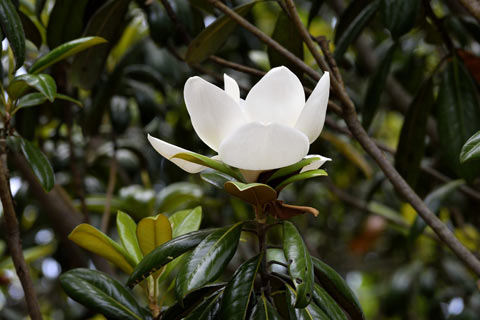
The difference between evergreen trees and deciduous trees becomes very obvious in the fall. Evergreens stay green and keep their foliage, while deciduous trees typically change the color of their leaves before dropping them and going dormant.
Evergreen trees do drop foliage, just not all at once. Throughout the year, they will drop small portions of their foliage and grow it back. These trees do not experience a dormant period like their deciduous counterparts, but they do slow down in the winter months.
For those with an aversion to raking up leaves in the fall, the arborist at 72tree.com identified 3 evergreen tree species to enhance your Alpharetta and Roswell Ga landscape.
Pine Trees
Of the North American native tree species, pine trees are one of the most widely spread and varied classes. Because of their ability to adapt and the ease to care for them, pines remain very popular landscaping trees from coast to coast.
Height – Within the pine family, some of the species can reach an astounding 150 feet tall and live to be more than 450 years old.
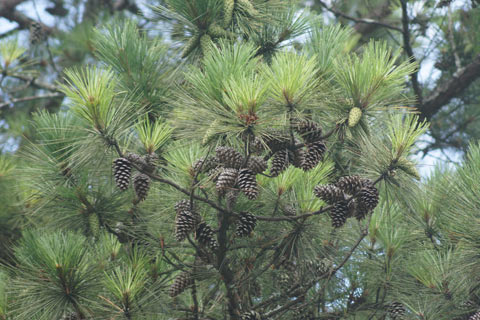
Crown Width – Mature pine tree canopies can stretch from 15 t0 30 feet in diameter depending on the species and the environment it is planted in.
DBH – When pines such as these reach maturity, their trunk DBH (diameter at breast height) can measure from 2.5 to 4 feet. As with most trees, there is just as much happening below ground.
Root System – As pines develop an extensive, deep, expansive, and invasive root system, they should not be planted within 20 feet of permanent structures like fences, underground utility lines, or homes.
Pest Problems – Bark beetles, aphids, and bagworms are a few of the pests that enjoy making a meal of pine trees. Mites and tree scale are also likely.
Disease – Some of the more common diseases that affect pine trees are needlecast, root rot, and pine wilt.
Pesticides and fungicides can be used to curb the progress of these pests and diseases. However, in cases of severe infestation and infection, an arborist should be called to evaluate the tree and what actions should be taken (including the tree’s removal if necessary).
Magnolia Trees
This classic Southern beauty (magnolia grandiflora) is very distinctive with its wide glossy leaves and enormous fragrant white blossoms. When it comes to year-round beauty, there are few trees that can keep up with it.

Its full luxurious look has made it a popular ornamental around the world.
This tree, although evergreen will drop leaves throughout the year. Growing anything beneath this tree (including grass) is difficult due to its dense foliage casting full shade and its shallow roots.
Height – A magnolia tree planted in a location with rich soil, little to no obstacles for the root system, and good soil drainage can reach heights of more than 80 feet.
Crown Width – While this tree possesses a pyramidal to rounded crown at the top, its width can reach 30 to 40 feet at the base and mid section.
DBH – Adult magnolias can reach a DBH of 24 to 36 inches. To reach this size takes anywhere from 80 to 100 years.
Root System – The species itself is a deep rooted one. First to develop is a strong tap root, then as the tree grows, many sunken roots will grow down from the root collar, and as the tree ages, major lateral roots will grow. When planted in areas with a high water table, the roots will grow more shallow and outward.
The optimum soil for this species is a rich, well drained, and slightly acidic one. When planting a magnolia, add generous amounts of organic material to the soil for the best growing conditions.
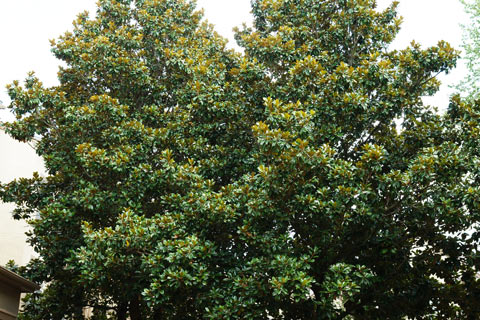
Although magnolia roots are not considered invasive, when planted too close to sidewalks or foundations, they will eventually cause undesired cracking and buckling.
Pest Problems – Varieties of scale, aphids, striped mealybug, spider mites, and magnolia leafminers are all potential infestation culprits.
Disease – There are a number of fungi which cause leaf spots. For the most part, they are unable to cause any significant damage to adult magnolias.
As well, there are a number of Polyporus fungi and Fomes which can cause heart rot.
Again, pesticides and fungicides can be used to curb the progress of these pests and diseases. When a severe infestation or infection is detected, an arborist should be called to assess what actions should be taken.
Eucalyptus Trees
Of all of the evergreen trees you could want in your yard, eucalyptus should be at or near the top of the list. This species is a fast growing, insect repelling, and gorgeous tree that adds beauty and practicality to whatever landscape it grows in.
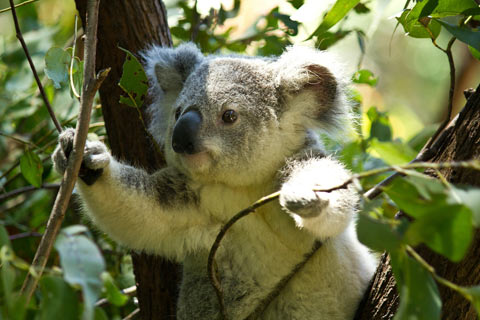
For most, the image you get when you hear “eucalyptus” is a koala bear latched on to a branch, munching away at the leaves. You may be surprised to learn that only the koala, some possum species, and a select few insects are actually able to consume parts of this species. In large quantities, this tree’s secret weapon (cineole) is toxic.
It is the cineole aka: eucalyptol in eucalyptus trees that make up the greatest part of its signature aroma. Eucalyptus essential oil has been used for centuries in the treatment of respiratory ailments, as a disinfectant, and as an antibacterial or anti-fungal agent in medicine.
Height – Eucalyptus tree sizes vary. Their height at maturity can range from 30 to 35 feet for smaller varieties all the way to over 200 feet for the tallest of the species.
These trees must be planted away from physical structures. Mature eucalyptus trees are known to unexpectedly drop branches.
Crown Width – The eucalyptus tree species will typically grow tall and relatively slender, with mature crowns reaching from 12 to 30 feet in diameter. Many varieties of the species are able to reach much greater diameters as they age.
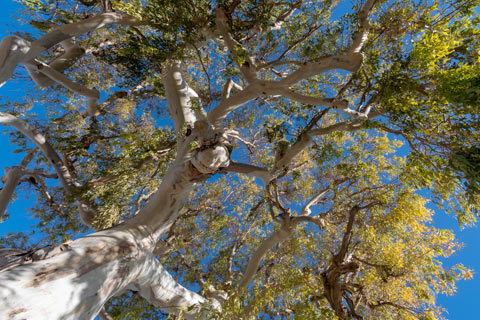
DBH – Adult eucalyptus trees can reach a DBH of 15 to 20 inches.
It is worth mentioning that this species is able to reach maturity within 10 years of growth. That’s less than half (in some cases less than a third) of the time it takes for the majority of other species to reach maturity.
Root System – This species quickly adapts to the soil it is planted in. In rich, fertile soil, the roots have no need to go deep. The tree is on a fast track for height and the roots will spread horizontally staying close to the surface.
In more nutrient deprived soil, the roots will dive deep for their food and moisture source. Counterintuitively, it is the eucalyptus planted in poor soil that grows to be the more stable and wind or storm resistant.
Pest Problems – Little to none (as long as the tree remains healthy). High concentrations of cineole in all parts of eucalyptus trees acts a natural insect repellant.
Two species of Australian tortoise beetles (family Chrysomelidae) (still isolated in the west) chew semicircular holes or notches on edges of eucalyptus leaves.
These beetles are able to remove most of a leaf’s surface, leaving only the midvein.The damage caused by these beetles is unsightly but not life threatening to the tree.
If a tree is stressed enough, an opportunity opens up for the eucalyptus longhorn borer. The female of this species lays her eggs on stressed trees, producing larvae that burrow their way to the cambium layer.
A heavily infested tree can die within weeks, which is due to the larval galleries girdling the tree and disrupting the flow of water and nutrients.
Infestations must be treated immediately. Because of the speed at which death can occur, an arborist should be called to evaluate the tree and determine what actions to take.
Disease – Canker, heart rot, and Phytophthora can infect a stressed eucalyptus tree. All three of these fungi attack and damage the tree from the inside.
Signs of infection are discolored leaves and in severe cases, splitting of the trunk. In any of these cases, the tree should be removed, destroyed (burned) and all equipment disinfected to prevent the disease from spreading to other trees.
Tree Care for Evergreens
As long as evergreens are planted in hardiness zones where they can thrive and get ample summer sunlight and winter shade (possibly on the north side of your property), caring for these trees is relatively simple.
Water them regularly and mulch around their trunk. This will keep them strong and winter injury resistant. Evergreens (when not mulched or watered well) can be severely injured by the drying effects of the sun and wind through winter months.
A major benefit of evergreens in your yard is that there is no bad season. Even during the coldest days of winter, your landscape will be filled with full, and vibrantly-green trees.
Sources:
http://ipm.ucanr.edu/PMG/PESTNOTES/pn74104.html
http://homeguides.sfgate.com/care-maintenance-evergreen-trees-59096.html
https://en.wikipedia.org/wiki/Salix_babylonica#Horticultural_selections_and_related_hybrids
https://gardenerdy.com/types-of-evergreen-trees
https://www.ambientbp.com/blog/7-facts-eucalyptus-trees
Notice: Undefined variable: page in /home/vrxdg1855sn3/public_html/wp-content/themes/72tree/content.php on line 15
Notice: Trying to get property 'ID' of non-object in /home/vrxdg1855sn3/public_html/wp-content/themes/72tree/content.php on line 15
4 Shrub Species for Your Alpharetta Georgia Yard
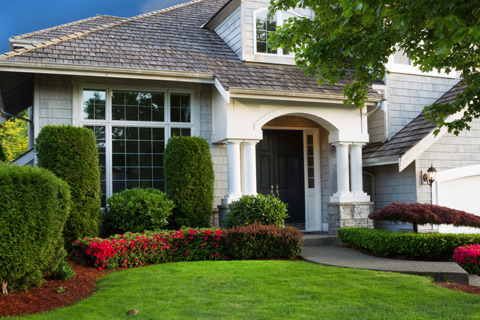
Trees, flowering shrubs, bushes, plants, and grass all work together to create a diverse ecosystem above and below the ground. While birds, insects, and other wildlife are attracted to the foliage, refuge, and blooms above, the roots are working below to find water, nutrients, and stability.
Choosing the right shrubs for your Alpharetta Ga landscape is a question of selecting ones that will thrive in the conditions of the environment where they are planted.
The team at 72tree.com has identified 4 shrub specimens that will enhance the natural beauty of your Alpharetta yard and landscape.
Hardiness Zone 7b Bushes and Shrubs for Alpharetta
The USDA Hardiness Zone Map divides North America into 11 planting zones. Each individual planting zone is around 10°F colder (or warmer) than its neighboring zone –during an average winter.
At your local nursery or garden supply store, plant identification tags usually identify the zone in which that species will thrive.
The city of Alpharetta is located in zone 7b with a humid subtropical climate which supports the following striking species:
Juniper – juniperus
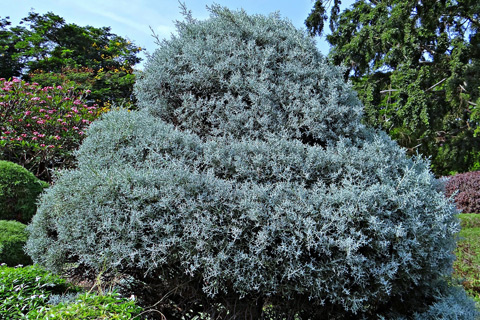
Junipers are long lived, slow growers, and rarely die. With a strong and extensive root system, they are able to adapt to their surrounding environment with ease. When planted in a location with ample space for growth, this specimen requires very little attention.
Juniper varieties vary in shape and size. The taller of the species can reach heights of more than 130 feet at maturity. The majority of the species however, are slow growing and will only reach about 30 feet in height, or 3 feet in diameter at maturity.
Junipers are evergreen and while they do not produce flowers or fruit, they do produce seeds.
Under the right conditions, this species can live from 400 to 700 years.
They are vulnerable to rust disease, which can be managed through pruning affected areas and treating them with fungicides.
Mountain Laurel – Kalmia latifolia
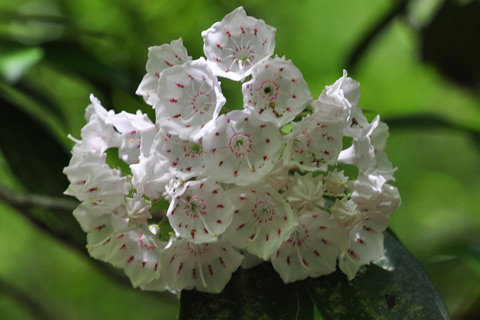
Mountain Laurels are relatively fast growers when properly planted. With a matted spreading root system, this shrub grows well in acidic well drained soil, and thrives when grown on north facing slopes or the east side of structures.
Mountain Laurel varieties are able to reach upwards of 25 feet, and if left to thrive without pruning, can grow into a large blooming thicket. Prolonged direct sunlight in summer months can stress this species. Take this into consideration when choosing its location.
This species is evergreen and produces flowers in terminal trusses of 50 to 150 blooms. Blooms range in color from white to pink and deep rose commonly with purple details. Flowering occurs in late spring (May and June).
This shrub however, is toxic. All of the green components – including the flowers, pollen, and twigs – contain andromedotoxin and is poisonous when ingested. If browsing animals consume enough of the plant, it can be lethal.
Mountain Laurel is vulnerable to leaf spot which can be managed through pruning affected areas and then treated with fungicides.
Rose of Sharon – Hibiscus Syriacus
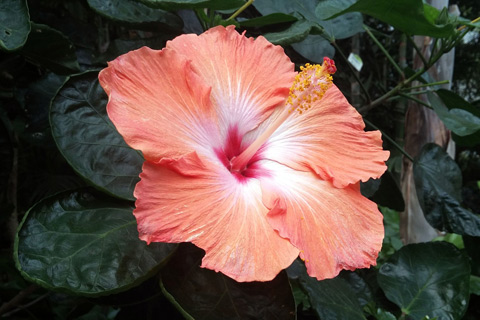
Rose of Sharon can be planted as a small tree or large shrub. It grows well in varied soil types but performs best in hot climates with moist soil and full sun.
At maturity, this species can reach up to 12 feet tall and grow 10 feet wide. Being multi-stemmed with vertical branches, it is relatively easy to grow, and requires minimal care. For this trait, Rose of Sharon is commonly used as hedging.
Rose of Sharon is a deciduous flowering shrub which with heavy pruning in early spring promotes flowering from July through September. Its flowers reach 2 to 4 inches in width, and blooms can range in color from pink, red, purple, white, and blue with a typically red center.
This species, if left unchecked, will reproduce and spread quickly in areas with little disturbance. Rose of Sharon is a vigorous and healthy species with high tolerance to pests and disease. When there is a problem with either, it is easily remedied through heavy pruning and with insecticides or fungicides.
Gardenia – Gardenia jasminoides
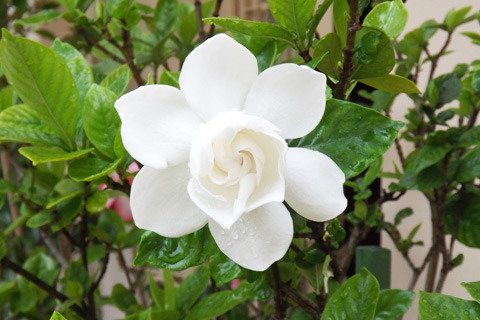
Gardenia can be planted as a small tree or large shrub. It thrives in acidic soil with good drainage, and flourishes in high humidity. This shrub grows best with night temperatures above 60 degrees, and mid to low 70’s during the day. Bright (not direct) sunlight is best for this species.
This shrub can typically grow up to 15 feet but some varieties are able to reach heights of 50 feet tall. With its many size and form variations, they are frequently used as hedges, ground cover, and even specimen plantings.
Gardenias are evergreen flowering shrubs and small trees that do require moderate attention and care. Flowering from April through July, the flowers can be solitary or in clusters; they range in color from white to pale yellow.
One of the greatest features of growing gardenias is its sweet scent. Once the species blooms however, the flowers quickly wilt when they come in contact with water.
Gardenias are highly susceptible to pest infestations. However, they can be easily managed with insecticidal soaps or horticultural oils. It also helps to maintain a high level of biodiversity in your garden which serves to attract predators of the insects threatening your garden.
Benefits of Shrubs Around Trees
Besides all of the artistic possibilities that come about on a landscape rich with trees and shrubs, during severe weather and strong winds, it is your shrubs and bushes that act as a wind buffer.
Shrubs and bushes do an excellent job at diverting wind, thus weakening it. This in turn spares the surrounding trees from taking the full force of potentially damaging winds.
Likewise, the bushes planted around your home will help shield it when the cold winter winds begin to blow.
Healthy Gardens and Landscapes Need Diversity
A healthy garden and landscape will have a variety of thriving tree, plant, and shrub species. Throughout the blooming season, as each species flowers, it attracts different insects and wildlife.
This biodiversity helps to stave off infestations. Likewise, the co-mingling of roots and fungi (in fertile soil) help to create a thriving mycorrhizal network below the soil that works to impede invasive diseases.
Remember to have a plan in mind when acquiring plants and shrubs for your garden and landscape. Not all shrubs can be planted equally, but they all can thrive in the right environment.
Sources:
http://buckjones.com/trees-shrubs-how-to-choose/
https://www.michigandnr.com/publications/pdfs/huntingwildlifehabitat/Landowners_Guide/Resource_Dir/Acrobat/Trees_and_Shrubs.PDF
http://www.lot-lines.com/5-reasons-to-reconsider-your-hatred-of-juniper-bushes/
https://en.wikipedia.org/wiki/Kalmia_latifolia
https://extension.psu.edu/mountain-laurel-diseases
https://www.uaex.edu/yard-garden/resource-library/plant-week/mountain-laurel-6-15-12.aspx
http://www.hort.uconn.edu/plants/detail.php?pid=204
https://communityenvironment.unl.edu/plant-month-rose-sharon
http://homeguides.sfgate.com/rose-sharon-tree-41486.html
http://gardeningsolutions.ifas.ufl.edu/plants/ornamentals/gardenias.html
https://en.wikipedia.org/wiki/Gardenia
https://plants.ces.ncsu.edu/plants/all/gardenia-augusta-g-jasminoides/
Notice: Undefined variable: page in /home/vrxdg1855sn3/public_html/wp-content/themes/72tree/content.php on line 15
Notice: Trying to get property 'ID' of non-object in /home/vrxdg1855sn3/public_html/wp-content/themes/72tree/content.php on line 15
Tree Buying Tips
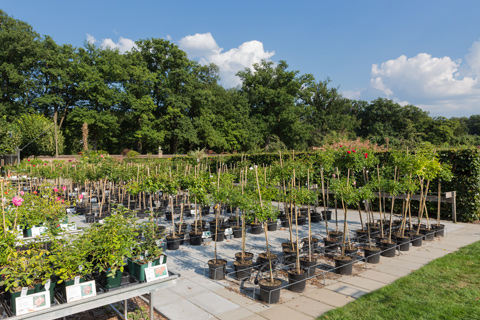 These tree buying tips will assist you in the purchasing of a healthy tree. Keep in mind that proper tree care starts when you select a tree, making the right selection will affect its shape, strength, and even its life span.
These tree buying tips will assist you in the purchasing of a healthy tree. Keep in mind that proper tree care starts when you select a tree, making the right selection will affect its shape, strength, and even its life span.
Research is key. Before buying trees, layout a plan of where they will be planted. Know how large they will grow, how far the canopy will extend, and how much space they will need to reach their maximum potential.
The Hardiness Zone Map will help you select appropriate trees for the geographic region they will be planted in. Consulting your local tree professional is always a good idea if you have any doubts.
The USDA Hardiness Zone Map Explained
The state of Georgia finds itself in zones 7-A & B and 8-A & B. A hardiness zone is based on a 30 year average of annual extreme minimum temperatures. It’s not based on the lowest recorded temperature in a region or what may happen in the future.
Keep this in mind as you choose plants and trees, especially if you are planning to “push” the hardiness zone by planting trees and plants not designated for your particular zone.
To learn more about the USDA hardiness zone read this: 72tree.com/trees-shrubs-usda-hardiness-zone-map/
The Right Season for Planting
Planting – There are two seasons for planting trees. Early spring and early fall. There is an interesting debate here. One side of the argument is that planting in early spring (when the tree is coming out of dormancy) reduces the shock and recovery time of the tree. The other side argues that planting in early fall allows the tree to establish its root system and adapt to its environment before entering dormancy.
Depending on the hardiness zone and the tree species, either season may be appropriate for planting. If you have any doubts, consult our tree service and professionals.
Transplanting – Regardless of how carefully performed, transplanting results in the damage of a great portion of the tree’s root system. It is important that the digging, moving, and replanting operations be carried out with the least possible damage to the remaining root system.
The recommended time for moving trees is during the dormant season. Early spring is generally the best time to transplant; conditions should be ideal for rapid root growth.
For more tree planting tips and details of the process, visit: treecareadvice.blogspot.com/2015/12/properly-planting-canadian-hemlock.html
Purchasing Bare Root vs Container Grown
Bare Root – Abundant root growth should be present, there should be fibrous and numerous small roots as well. They should have good color to them being flexible and moist. Deciduous trees should present roots equal in length to its stems.
Container Grown – Avoid trees that have become root bound in their container. Roots circling around in the container will likely become circling roots (cut them when planting).
NOTE: Examine the tree’s roots, trunk, and canopy. Trees are able to absorb water from the tips of their youngest roots and undisturbed, fibrous, and non-circling root systems are your best option.
Buying Strong and Healthy Trees
When deciding on which trees to purchase for your landscape or project, keep in mind that the Hardiness Zone Map will guide you by the geographic region you are planting in, while the season you are planting in will determine if you should plant or transplant.
Whether you choose bare root or container grown, be sure to inspect the roots, trunk and canopy. Avoid trees that don’t meet your standards, and always look for the strong and healthy ones.
Notice: Undefined variable: page in /home/vrxdg1855sn3/public_html/wp-content/themes/72tree/content.php on line 15
Notice: Trying to get property 'ID' of non-object in /home/vrxdg1855sn3/public_html/wp-content/themes/72tree/content.php on line 15
Trees, Shrubs, and the USDA Hardiness Zone Map
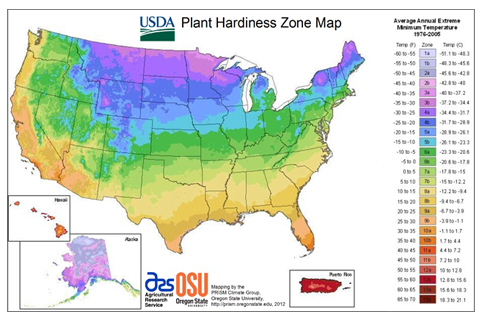
If you have ever gone into the nursery and picked a plant or tree, later to realize it was not suitable to be planted in the environment in which you live, this can be avoided. Besides the scientific plant name and care instructions, you will notice the hardiness zone printed on its tag.
The USDA Hardiness Zone Map splits North America up into 11 separate planting zones. Each individual planting zone is around 10°F colder (or warmer) than the adjacent zone during an average winter. If you’re reading a plant description in a gardening magazine and you see a mention of a hardiness zone, then it’s likely referring to the USDA Hardiness Zone map.
What are Hardiness Zones?
A hardiness zone is based on average annual extreme minimum temperatures across a 30-year period. It’s not based on the lowest recorded temperature in a region or what might possibly happen in the future. Gardeners must keep this in mind as they choose plants and trees, especially if they are planning to “push” the hardiness zone they live in by planting trees and plants not suited for that particular hardiness zone. Something else to keep in mind is that there could be microclimates that won’t show up on a map – even one as detailed as the current USDA PHZM map.
Eastern Zones vs Western Zones
Eastern Zones – The USDA map is great at its job of outlining the different gardening climates of the eastern half of North America. This is a comparatively flat area, which means it can be mapped out by drawing lines approximately parallel to the Gulf Coast around every 120 miles as you progress north. The lines will start to tilt northeast as the Eastern Seaboard approaches. The USDA map also accounts for the special climates caused by the Appalachian mountains and the Great Lakes.
Western Zones – A range of factors including winter lows, elevation and precipitation determine the growing climates in western North America. The weather in the west floats in from the Pacific Ocean, becoming less humid as it moves around the mountain ranges to the west. The growing climates in the west can vary quite a bit compared to the east, where cities in similar zones can grow the same plants in the same climates. The weather – and the plants that can be grown in it – in coastal Seattle are much different than what you can expect in the higher and more inland Tucson, Arizona. This is in spite of both cities being a part of zone 8 of the USDA map.
To find the zone for where you live, see http://planthardiness.ars.usda.gov/PHZMWeb/
Ideal Trees and Shrubs for Alpharetta and Roswell Ga
Many of our customer’s aim to improve their well-manicured yards with trees, shrubs, and flowers. Of course the right sunlight, soil, and moisture conditions are factors needed for these plants to flourish. After being asked for specific species, we created a short list of popular trees and common shrubs that will thrive in Alpharetta and Roswell Ga. 7a and 7b are the zones for North Georgia, so next time you visit the nursery, be sure to look for plants that are conducive to living in these zones.
Other Factors to Consider with the Hardiness Zone Map
There are other environmental factors that determine whether a plant succeeds or fails on top of the hardiness zones. Wind levels, soil type and moisture, humidity, pollution, winter sunshine, and snow are all major contributing factors to plant survival. Whether or not a plant survives can also depend on where it is planted, how it is planted, their size, and their overall health.
The map was most recently updated in 2012 when the USDA adjusted the plant hardiness map to account for the warmer global temperatures occurring over the past thirty years. Refer to this resource when purchasing trees and plants for your garden and landscape.
Interactive Map: http://planthardiness.ars.usda.gov/phzmweb/interactivemap.aspx
